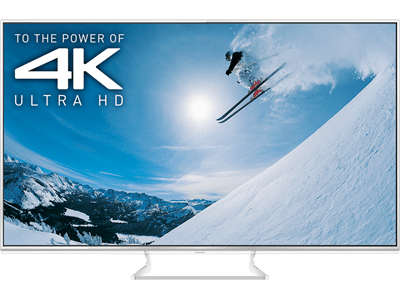This article was originally published on www.display-central.com.
4K content and delivery, long considered the gating issue for mainstream UHD adoption, is developing at a fast pace in Europe as evidenced by the recent IFA, Berlin. Here’s a consolidated news round-up on announcements from the recent IFA Berlin show and subsequent press releases. Coverage includes new UHD satellite and cable signal announcements, over the top internet delivery of UHD signals and new SOC chips and STB’s that will help deliver the goods to the home perhaps much sooner rather than later.
End-to-End Satellite Delivery of 4K Content
At IFA, DVB teamed with Eutelsat Communications to show off its 4K content delivery using a DVB-S2 transmission systems with modulators and demodulators used in the transport. Eutelsat (satellite 10A) and Sky Deutschland both provided the satellite transponder space, and used the new Broadcom receiver to decode the content (see below.) Content was shown using an LG UHD display. The group also showed a Paris-based Uplink station using DVB-S2 transported to an HVEC decoder at the exhibit. Finally an H.264 encoded 4K signal was transmitted via DVB-S2 from Paris, directly to an integrated S2 display at the IFA show floor.
Ericsson was also showing off results from its live testing of 4K content as the company teamed with Eutelsat, Globecast, Newtec and SKY Italia with the announcement of successful end-to-end satellite-based delivery chain. Sky Italia produced the 4K content in quad HD format (2160p) at 60 Hz. The company said it used a variety of camera brands and video mixers in the 4K content production chain. This included live sequences in quad 3G-SDI signal using an Ericsson AVP 2000 encoder compressed in MPEG-4 AVC at 60 Hz and 10-bit, 4:2:2 color sampling. The Ericsson test used a Newtec AZ110 Satellite modulator (DVB-S2 16APSK modulation) at 89Mbps throughput using a conventional 36 MHz Ku Transponder (using Eutelsat 5WestA). Globecast provided the satellite uplink using one of its HD ENG trucks with a 1.5m antenna aimed at the satellite and a 400W amp to transmit the signal. The group reported 99.97% signal availability using 4x Ericsson (RX8200) receivers that fed a quad HD display.
DVB C2 (cable)
Also at IFA was DVB and Kabel Deutschland (KD) demonstrating the first ever 4K video over the DVB-C2 transmission system (modulator / demodulator). The 4K exercise was a bit academic for the group as they already showed DVB-C2 capability in June, 2013. DVB with Kabel Deutschland announced field trials using the DVB-C2 standard in a transmission on cable channel D794 on networks in Berlin, Hamburg and Munich. The group said it expects the bandwidth to increase maximum downstream capacity in the 862 MHz cable network from the current 5 Gbps to 8 Gbps.
KD said it used the DVB-C2 1024-QAM modulation scheme at 3/4 FEC-rate deployed on a network offering a whopping 46% improvement to the spectrum efficiency in relation to DVB-C at the same signal level. Lorenz Glatz, KD’s CTO said the efficiency will help the company with its “competitiveness” and its customers “…can look forward to a new range of products and services.” The EU based cable TV group said they expect to distribute DVB-C2 compliant set top boxes to select customers. Beyond UHD signal reception, the group said its customers will benefit from the move to OFDM (orthogonal frequency division multiplexing) and the LDPC error protection system both targeted for the DOCSIS 3.1 standard (short for data over cable service interface spec.) Field trials for DVB-C2 go back as far as 2011. At that time, the first ever prototype IDTV with DVB-C2 tuner was demonstrated in Cologne, Germany showing 4 HD channels using QAM over an 8 MHz channel at 80 Mbps.
4K Content via Internet
At IFA, Sweden-based Net Insight’s CTO Per Lindgren spoke about 1 Gbps compression of 4K signals for internet distribution over gigabit-ethernet networks (1 G-E). The company announced its Nimbra 600 MSR series with lossless transmission of 4K data streams using JPEG 2000 compression. Keep in mind that uncompressed 4K video requires 12 Gbps, well beyond existing 10-GE. The compression into existing network infrastructures will vastly improve workflow. He also said using 4K content is actually more efficient as the UHD content from a single camera can cover wider areas, and during production, content can be reused by zooming in and out, adding to efficiency. 1Mbps compression also opens 4K content to the more efficient and less expensive internet as a primary distribution path. Lindgren said to look at Sports venues as the first adopter of this approach. Other products include a Nimbra 390 Media Switch Router for 4K content (video) transport over the internet that maintains a signal even with 30% packet loss using its forward error correction.
Finally on the chip side, Broadcom announced a new family of HEVC (high efficiency video coding) SOC (system on chip.) They include the BCM7251 for multi-HD IP set top box and a Direct Broadcast satellite chip the BCM7366. The latter is a full band capture front end receiver working with two corresponding chips,BCM7439 and 7376, both MoCA 2.0 enabled (multimedia over coax) for cable and satellite video gateways. For IP client support, Broadcom offers the BCM7438 SOC, an HEVC companion chip, all designed to be combined with the flagship (previously announced BCM7445 UHD SOC a 4Kx2K TV home gate way (video decoder) chip launched in January 2013.
While there is still a long road ahead for UHD content delivery, things were made a bit more clear from across the pond at IFA in Berlin this month. The continent has the advantage of almost ubiquitous DVB adoption that will help move the UHD content delivery along, and that’s a good thing for all concerned. – Steve Sechrist

